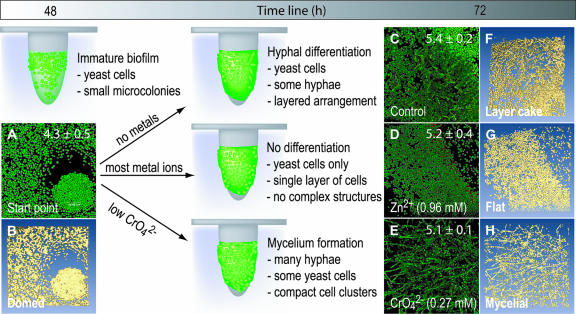FIG. 3.
C. tropicalis 99916 forms biofilm communities with characteristic 3D structure that may be influenced by metal ions. Here, the heavy metal ions Zn2+ and CrO42− influenced the maturation of C. tropicalis communities at an intermediate stage of biofilm development. In these experiments, C. tropicalis was grown on pegs in the CBD and was then exposed to Zn2+ and CrO42− for 24 h. The exposed biofilms were stained with the Live/Dead BacLight kit, imaged by CLSM, and then visualized using amira 3.1. The mean and standard deviation of biofilm cell densities were evaluated by viable cell counting (log10 CFU peg−1), and this is indicated where appropriate. (A and B) The 2D average projection and isosurface rendering of a C. tropicalis biofilm grown for 48 h on the CBD. This “domed” biofilm structure type was named for the formation of small microcolonies of yeast cells in surface-adherent communities. (C and F) The 2D average projection and isosurface rendering of an untreated C. tropicalis biofilm grown for a total of 72 h. This structure type was named “layer cake” for the biphasic arrangement of yeast and hyphal cells in the community. (D and G) The 2D average projection and isosurface rendering of a C. tropicalis biofilm exposed to 0.96 mM Zn2+ for 24 h. These “flat” biofilms had few hyphae and lacked microcolony structures. (E and H) The 2D average projection and isosurface rendering of a C. tropicalis biofilm exposed to 0.27 mM CrO42− for 24 h. “Mycelial” biofilms consisted of masses of hyphal cells attached to the polystyrene surface with few yeast cells remaining in the community. Each panel represents an area of 238 by 238 μm. Green cells are alive, and red cells are dead.

